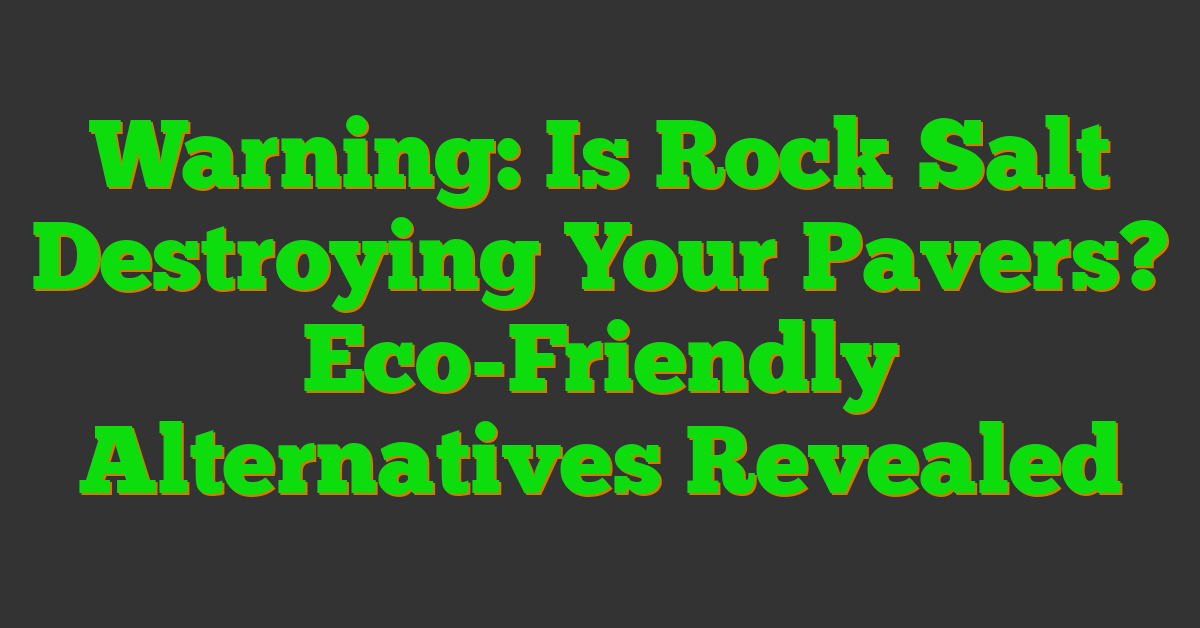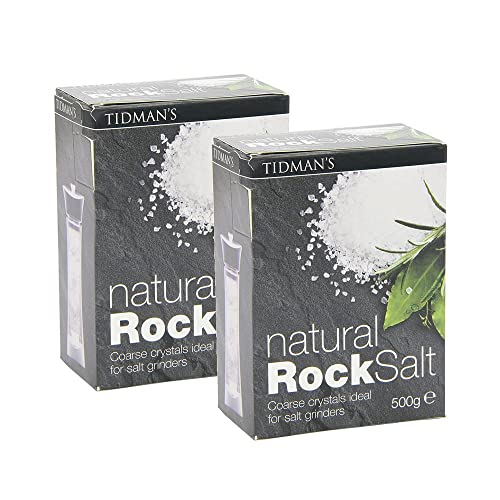If you’re like us and enjoy the winter season, you’re probably familiar with the sight of rock salt scattered on walkways and driveways to melt snow and ice. However, have you ever wondered if this common de-icing method could be harming your pavers? In this article, we’ll explore the question: is rock salt bad for pavers?

We all want our outdoor spaces to look their best, and maintaining pavers is an essential part of that. Rock salt’s effectiveness in combating icy surfaces is unquestionable, but what impact does it have on the durability and aesthetics of your pavers? Let’s delve into the potential effects of rock salt on these hardscapes to help you make informed decisions for your winter maintenance routine.
Understanding Rock Salt and Pavers
What Is Rock Salt?
As landscape designers, we often encounter clients using rock salt to deice their walkways and driveways. Rock salt, also known as sodium chloride, is a common deicing material used to melt snow and ice due to its affordability and effectiveness. When rock salt comes into contact with ice, it lowers the freezing point of water, causing the ice to melt and creating safer walking surfaces. However, while rock salt is practical for winter maintenance, it’s essential to consider its potential impact on pavers.
Types of Pavers Affected by Rock Salt
In our experience, certain types of pavers are more susceptible to damage from rock salt than others. Pavers made of concrete or unsealed natural stone are particularly vulnerable to the corrosive effects of rock salt. Concrete pavers may experience surface pitting, scaling, or discoloration when exposed to rock salt over time. Similarly, unsealed natural stone pavers, such as limestone or travertine, can suffer from etching and staining caused by the chemical reaction between the rock salt and the stone.
As landscape designers, we advise our clients to consider alternative deicing methods or take preventive measures to protect their pavers from the potential harm of rock salt. By understanding the interaction between rock salt and different paver materials, we can help preserve the durability and aesthetics of outdoor spaces while ensuring safety during the winter months.
The Impact of Rock Salt on Pavers
Corrosive Effects on Concrete and Brick Pavers
When it comes to rock salt and pavers, one significant aspect to consider is how it affects concrete and brick pavers. The use of rock salt as a deicing agent can lead to corrosive effects on these types of pavers. Concrete, in particular, is vulnerable to damage from the salts found in rock salt. The salt can penetrate the surface, causing pitting and scaling over time. Similarly, brick pavers can also suffer from deterioration due to the corrosive nature of rock salt. As landscape designers, we advise opting for deicing alternatives or protective measures to maintain the integrity of concrete and brick pavers in outdoor spaces.
How Salt Affects the Aesthetics of Pavers
Rock salt’s impact on pavers goes beyond functionality; it can also affect the aesthetics of the outdoor space. When rock salt is used repeatedly on pavers, it can cause discoloration and staining. Concrete pavers may develop white marks or stains, while natural stone pavers can lose their original color due to exposure to salt. As landscape designers, we recommend considering the visual appeal of pavers and exploring deicing options that minimize aesthetic damage while ensuring safety during winter.
The Long-Term Consequences for Paver Durability
Considering the long-term consequences for paver durability is crucial when using rock salt for deicing. Pavers exposed to rock salt over multiple winter seasons can experience accelerated deterioration. Concrete pavers may show signs of wear and require more frequent maintenance to preserve their structural integrity. Similarly, brick pavers can weaken over time, affecting the overall stability of outdoor walkways and driveways. As landscape designers, we advocate for proactive measures to protect the durability of pavers, such as sealants or alternative deicing methods, to prolong their lifespan and maintain the beauty of outdoor spaces.
Alternatives to Rock Salt for Paver Safety
As landscape designers, we understand the importance of preserving the beauty and integrity of pavers while ensuring safety during winter months. Exploring eco-friendly deicing options and preventative measures to safeguard pavers is crucial for sustainable outdoor spaces.
Eco-Friendly Deicing Options
When it comes to protecting pavers without harming the environment, we recommend considering eco-friendly deicing alternatives. These options effectively melt ice and snow while minimizing the negative impact on paver surfaces and surrounding vegetation. Some eco-friendly deicers include:
- Calcium Magnesium Acetate (CMA): CMA is a salt-free deicer that is less harmful to pavers and greenery compared to traditional rock salt. It works well at higher temperatures and helps prevent corrosion.
- Potassium Acetate: This deicer is biodegradable and less damaging to pavers and plants. Potassium acetate is effective at melting ice without leaving behind harmful residues.
- Beet Juice-based Deicers: Deicing solutions made from beet juice are gaining popularity as they are environmentally friendly and work well at lower temperatures.
By choosing eco-friendly deicing options, we can protect pavers from deterioration while promoting sustainability in outdoor maintenance practices.
Preventative Measures to Protect Pavers
To ensure the longevity of pavers and prevent damage caused by deicing agents, implementing preventative measures is essential. These strategies can help maintain the structural integrity and aesthetic appeal of outdoor surfaces:
- Sealing Pavers: Applying a sealant to pavers creates a protective barrier that shields them from the corrosive effects of deicers. Sealants help prevent discoloration, efflorescence, and surface deterioration.
- Regular Cleaning: Keeping pavers clean and free of debris can prevent staining and enhance their visual appeal. Regular sweeping and washing can remove dirt, salt residue, and other contaminants that may compromise the paver’s finish.
- Proper Drainage: Ensuring adequate drainage around pavers can prevent water and deicing agents from pooling, which can accelerate deterioration. Properly sloped surfaces and functional drainage systems are key to preserving paver quality.
By incorporating these preventative measures into paver maintenance routines, we can protect outdoor surfaces from weather damage and maintain their beauty for years to come.
Best Practices for Paver Maintenance in Winter
As landscape designers, we understand the importance of maintaining the beauty and longevity of your outdoor pavers, especially during the harsh winter months. Here are some essential practices to help you care for your pavers effectively in winter.
Proper Cleaning Techniques After Salt Exposure
When winter weather hits and rock salt is used for deicing, it’s crucial to clean your pavers promptly to prevent damage. Here’s how we recommend cleaning your pavers after exposure to salt:
- Rinsing with Water: Start by thoroughly rinsing the pavers with water to remove any salt residue on the surface. A gentle hose spray can be effective in washing away the salt without causing any abrasive damage.
- Scrubbing with a Mild Cleaner: If salt stains persist, use a mild cleaning solution specifically designed for pavers. Avoid harsh chemicals that can harm the pavers’ finish. Gently scrub the affected areas with the cleaner to lift stubborn salt deposits.
- Avoiding Abrasive Tools: Refrain from using abrasive tools like wire brushes or metal scrapers as they can scratch and damage the paver surface. Opt for soft bristle brushes or natural sponges to clean the pavers effectively without causing harm.
By following these cleaning techniques after salt exposure, you can maintain the pristine condition of your pavers and prevent any long-term damage caused by rock salt.
Seasonal Care Tips for Paver Longevity
To ensure the longevity of your pavers throughout the winter season and beyond, consider these seasonal care tips:
- Sealing Pavers: Before the onset of winter, seal your pavers with a quality sealant to create a protective barrier against moisture and salt infiltration. Sealants help maintain the pavers’ color and resist stains, enhancing their durability.
- Regular Cleaning: Establish a routine cleaning schedule to remove debris, leaves, and other organic matter that can accumulate on the pavers. Regular sweeping and occasional washing can prevent mold and mildew growth, preserving the pavers’ appearance.
- Ensuring Proper Drainage: Check the drainage around your pavers to prevent water accumulation, especially during freeze-thaw cycles. Proper drainage helps minimize water infiltration and reduces the risk of paver shifting or cracking due to frost heave.
By incorporating these seasonal care tips into your paver maintenance routine, you can enjoy a beautiful outdoor space year-round while safeguarding the integrity of your pavers in winter conditions.
Conclusion
While rock salt is effective for snow and ice removal, it can potentially harm pavers. Exploring eco-friendly alternatives like Calcium Magnesium Acetate, Potassium Acetate, and Beet Juice-based deicers can help protect both pavers and the environment. By following best practices for winter paver maintenance, such as proper cleaning techniques post-salt exposure and seasonal care tips like sealing pavers and ensuring good drainage, we can preserve the beauty and longevity of outdoor pavers in harsh winter conditions. Let’s prioritize the health of our pavers and the environment by making informed choices for snow and ice removal.
















